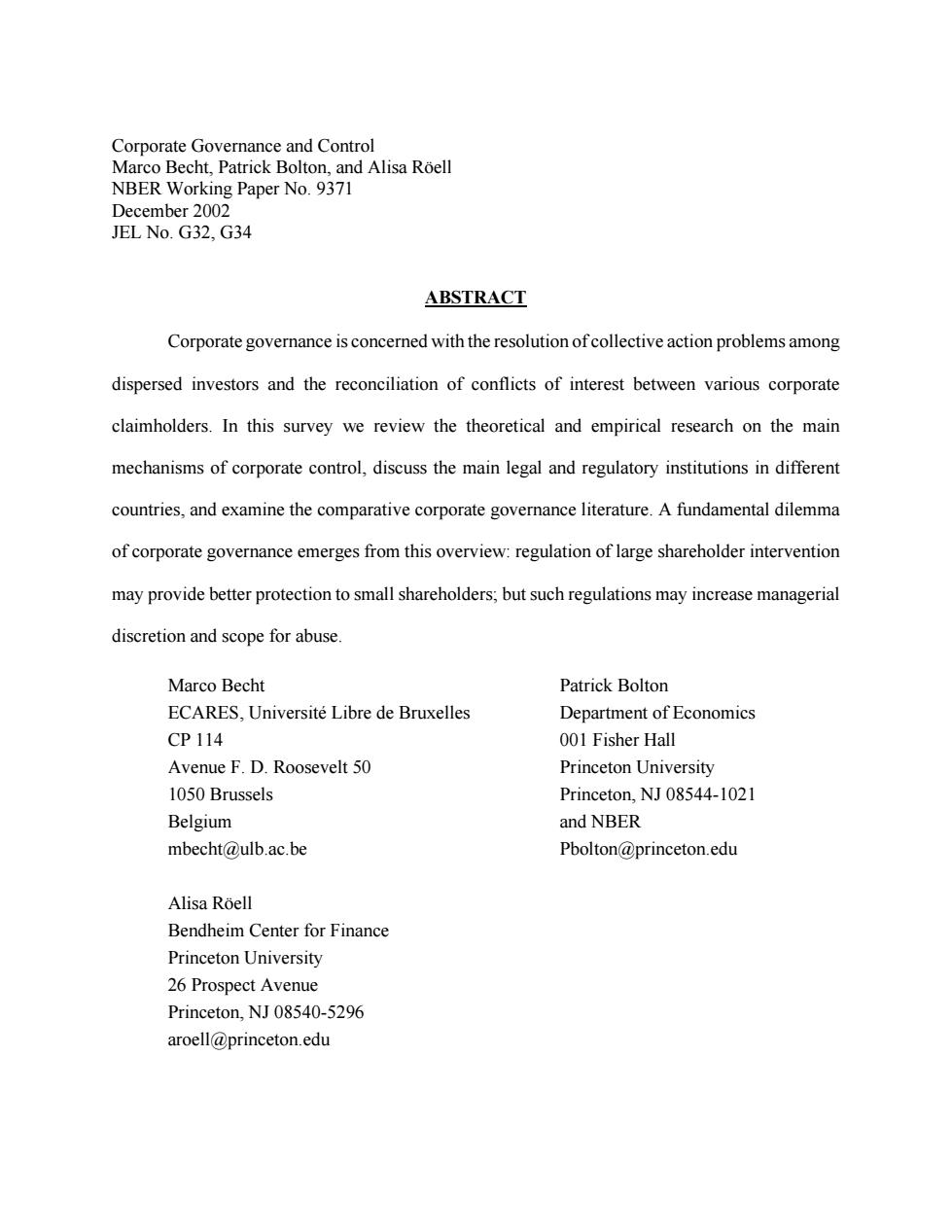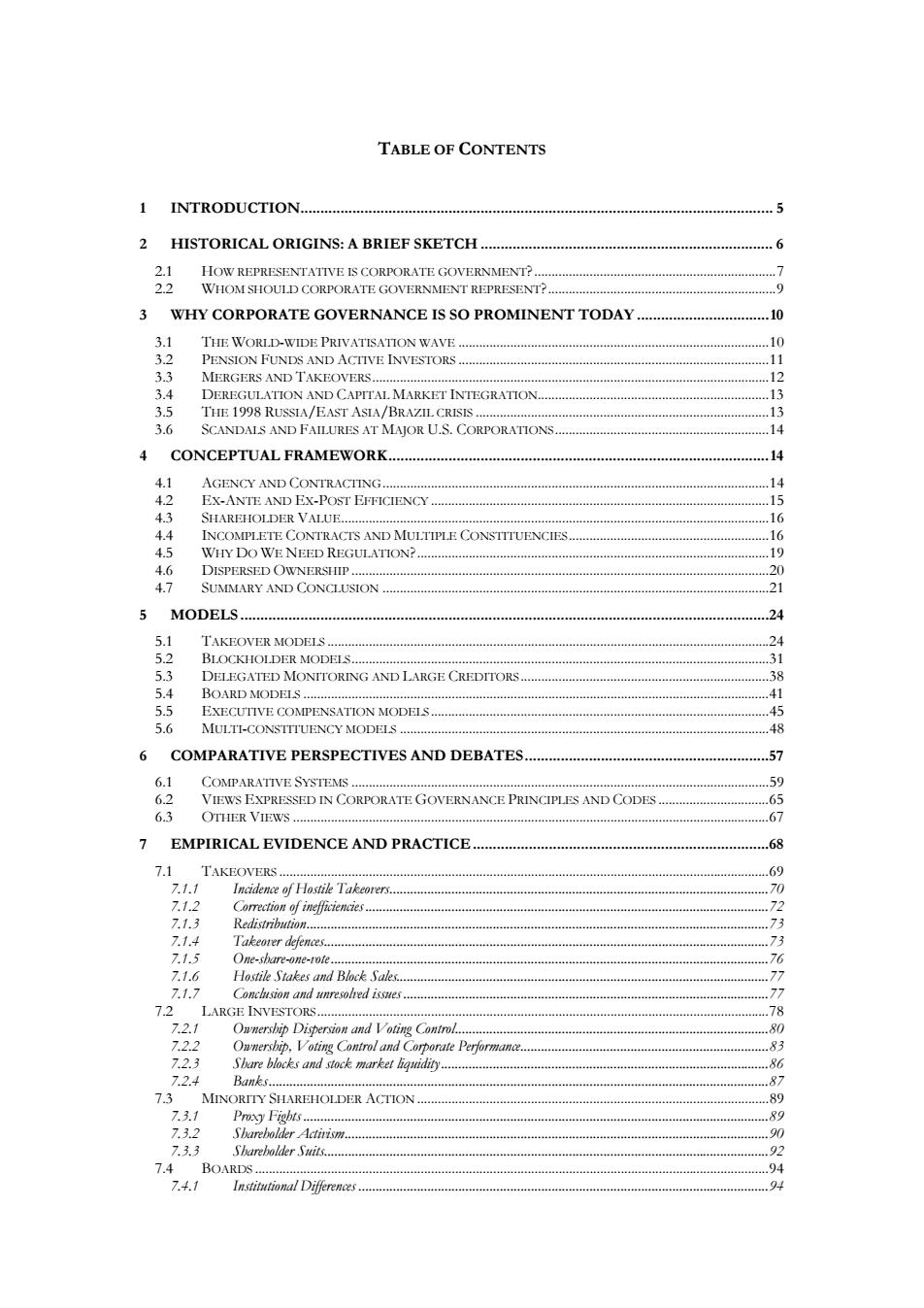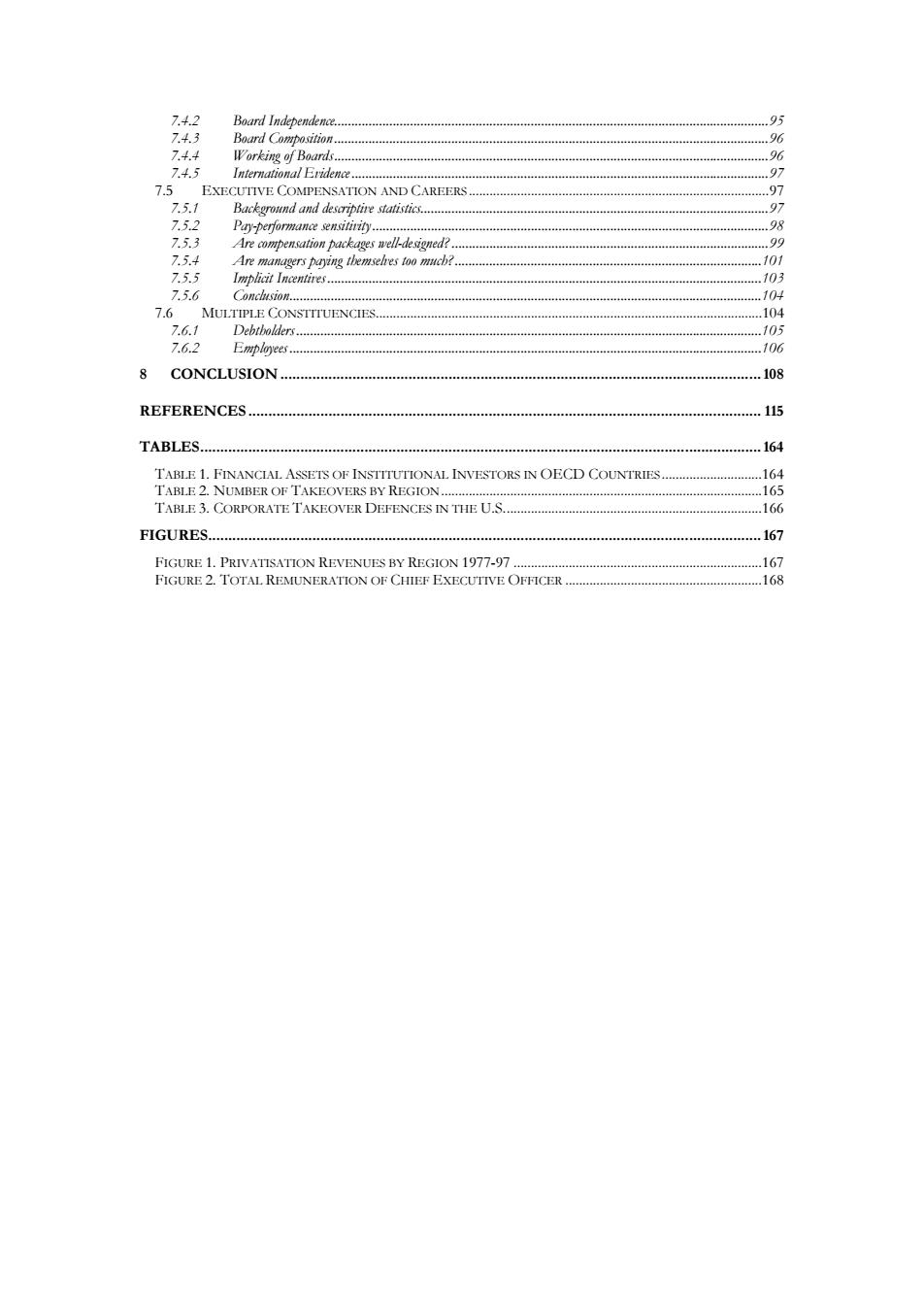
NBER WORKING PAPER SERIES CORPORATE GOVERNANCE AND CONTROL Marco Becht Patrick Bolton Alisa Roell Working Paper 9371 http://www.nber.org/papers/w9371 NATIONAL BUREAU OF ECONOMIC RESEARCH 1050 Massachusetts Avenue Cambridge,MA 02138 December 2002 Literature survey prepared for the Handbook of the Economics of Finance,edited by George Constantinides, Milton Harris and Rene Stulz,North-Holland (2002).We are grateful to Bernardo Bortolotti,Mathias Dewatripont,Richard Frederick,Stu Gillan,Peter Gourevitch,Milton Harris,Gerard Hertig,Takeo Hoshi, Steve Kaplan,Roberta Romano,Christian Rydqvist and Scott Verges for helpful input and comments.The views expressed herein are those of the authors and not necessarily those of the National Bureau of Economic Research 2002 by Marco Becht,Patrick Bolton,and Alisa Roell.All rights reserved.Short sections of text,not to exceed two paragraphs,may be quoted without explicit permission provided that full credit,including notice,is given to the source
NBER WORKING PAPER SERIES CORPORATE GOVERNANCE AND CONTROL Marco Becht Patrick Bolton Alisa Röell Working Paper 9371 http://www.nber.org/papers/w9371 NATIONAL BUREAU OF ECONOMIC RESEARCH 1050 Massachusetts Avenue Cambridge, MA 02138 December 2002 Literature survey prepared for the Handbook of the Economics of Finance, edited by George Constantinides, Milton Harris and René Stulz, North-Holland (2002). We are grateful to Bernardo Bortolotti, Mathias Dewatripont, Richard Frederick, Stu Gillan, Peter Gourevitch, Milton Harris, Gerard Hertig, Takeo Hoshi, Steve Kaplan, Roberta Romano, Christian Rydqvist and Scott Verges for helpful input and comments.The views expressed herein are those of the authors and not necessarily those of the National Bureau of Economic Research. © 2002 by Marco Becht, Patrick Bolton, and Alisa Röell. All rights reserved. Short sections of text, not to exceed two paragraphs, may be quoted without explicit permission provided that full credit, including © notice, is given to the source

Corporate Governance and Control Marco Becht,Patrick Bolton,and Alisa Roell NBER Working Paper No.9371 December 2002 JEL No.G32,G34 ABSTRACT Corporate governance is concerned with the resolution of collective action problems among dispersed investors and the reconciliation of conflicts of interest between various corporate claimholders.In this survey we review the theoretical and empirical research on the main mechanisms of corporate control,discuss the main legal and regulatory institutions in different countries,and examine the comparative corporate governance literature.A fundamental dilemma of corporate governance emerges from this overview:regulation of large shareholder intervention may provide better protection to small shareholders;but such regulations may increase managerial discretion and scope for abuse. Marco Becht Patrick Bolton ECARES,Universite Libre de Bruxelles Department of Economics CP114 001 Fisher Hall Avenue F.D.Roosevelt 50 Princeton University 1050 Brussels Princeton,NJ 08544-1021 Belgium and NBER mbecht@ulb.ac.be Pbolton@princeton.edu Alisa Roell Bendheim Center for Finance Princeton University 26 Prospect Avenue Princeton,NJ 08540-5296 aroell@princeton.edu
Corporate Governance and Control Marco Becht, Patrick Bolton, and Alisa Röell NBER Working Paper No. 9371 December 2002 JEL No. G32, G34 ABSTRACT Corporate governance is concerned with the resolution of collective action problems among dispersed investors and the reconciliation of conflicts of interest between various corporate claimholders. In this survey we review the theoretical and empirical research on the main mechanisms of corporate control, discuss the main legal and regulatory institutions in different countries, and examine the comparative corporate governance literature. A fundamental dilemma of corporate governance emerges from this overview: regulation of large shareholder intervention may provide better protection to small shareholders; but such regulations may increase managerial discretion and scope for abuse. Marco Becht Patrick Bolton ECARES, Université Libre de Bruxelles Department of Economics CP 114 001 Fisher Hall Avenue F. D. Roosevelt 50 Princeton University 1050 Brussels Princeton, NJ 08544-1021 Belgium and NBER mbecht@ulb.ac.be Pbolton@princeton.edu Alisa Röell Bendheim Center for Finance Princeton University 26 Prospect Avenue Princeton, NJ 08540-5296 aroell@princeton.edu

TABLE OF CONTENTS 1 INTRODUCTION.… .5 2 HISTORICAL ORIGINS:A BRIEF SKETCH.................. 6 2.1 HOW REPRESENTATIVE IS CORPORATE GOVERNMENT?........ .7 2.2 WHOM SHOULD CORPORATE GOVERNMENT REPRESENT?. 9 3 WHY CORPORATE GOVERNANCE IS SO PROMINENT TODAY...........0 3.1 THE WORLD-WIDE PRIVATISATION 3.2 PENSION FUNDS AND ACTIVE INVESTORS .11 3.3 MERGERS AND TAKEOVERS..... 3.4 DEREGULATION AND CAPITAL MARKET INTEGRATION. 12 13 3.5 THE 1998 RUSSIA/EAST ASIA/BRAZILCRISIS13 3.6 SCANDALS AND FAILURES AT MAJOR U.S.CORPORATIONS........................14 4 CONCEPTUAL FRAMEWORK........... 14 4.1 AGENCY AND CONTRACTING............ 444444 .14 4.2 EX-ANTE AND EX-POSTEFFICIENCY....15 4.3 SHAREHOLDER VALUE........ 16 4.4 INCOMPLETE CONTRACTS AND MULTIPLE CONSTTTUENCIES.... 4444444444444444444444444 .16 4.5 WHY DO WE NEED REGULATIONP.. 19 4.6 DISPERSED OWNERSHIP 20 4.7 SUMMARY AND CONCLUSION ...... .21 5 MODELS 24 5.1 TAKEOVER MODELS...... 24 5.2 BLOCKHOLDER MODELS........... 31 5.3 DELEGATED MONITORING AND LARGE CREDITORS 38 5.4 B0 ARD MODELS… .41 5.5 EXECUTIVE COMPENSATION MODELS............. 45 5.6 MULTI-CONSTTTUENCY MODELS ............. 48 6 COMPARATIVE PERSPECTIVES AND DEBATES .57 6.1 COMPARATIVE SYSTEMS. 59 6.2 VIEWS EXPRESSED IN CORPORATE GOVERNANCE PRINCIPLES AND CODES..... 65 6.3 OTHER VIEWS.. .67 EMPIRICAL EVIDENCE AND PRACTICE .…68 7.1 TAKEOVERS..... .69 7.1.1 ncidence0fH0.slie☑ke0le.………..70 7.1.2 7.1.3 Recpspppbppiop3 7.1.4 Takeo1 er defences.…… .73 7.1.5 One-share-one-rote... 76 7.1.6 Hostile Stakes and Block Sales. 7.1.7 77 7.2 LARGE INVESTORS.18 7.2.1 Ownership Dispersion and Voting Control. .80 7.2.2 Ownership.Voting Control and Corporate Performance.. 83 7.2.3 Sbare blocks and stock market liquidity. 86 7.2.4 Bahk 87 7.3 MINORITY SHAREHOLDER ACTION......89 73.1 Poxy Fiobts 8 7.3.2 Sbarebolder Activism..... .90 7.3.3 Sbarebolder Suits.. 92 7.4BOARDS. .94 7.4.1 Institutional Differences...... 94
TABLE OF CONTENTS 1 INTRODUCTION...................................................................................................................... 5 2 HISTORICAL ORIGINS: A BRIEF SKETCH ......................................................................... 6 2.1 HOW REPRESENTATIVE IS CORPORATE GOVERNMENT?......................................................................7 2.2 WHOM SHOULD CORPORATE GOVERNMENT REPRESENT?..................................................................9 3 WHY CORPORATE GOVERNANCE IS SO PROMINENT TODAY .................................10 3.1 THE WORLD-WIDE PRIVATISATION WAVE ..........................................................................................10 3.2 PENSION FUNDS AND ACTIVE INVESTORS ..........................................................................................11 3.3 MERGERS AND TAKEOVERS...................................................................................................................12 3.4 DEREGULATION AND CAPITAL MARKET INTEGRATION...................................................................13 3.5 THE 1998 RUSSIA/EAST ASIA/BRAZIL CRISIS .....................................................................................13 3.6 SCANDALS AND FAILURES AT MAJOR U.S. CORPORATIONS..............................................................14 4 CONCEPTUAL FRAMEWORK...............................................................................................14 4.1 AGENCY AND CONTRACTING................................................................................................................14 4.2 EX-ANTE AND EX-POST EFFICIENCY ..................................................................................................15 4.3 SHAREHOLDER VALUE............................................................................................................................16 4.4 INCOMPLETE CONTRACTS AND MULTIPLE CONSTITUENCIES..........................................................16 4.5 WHY DO WE NEED REGULATION?......................................................................................................19 4.6 DISPERSED OWNERSHIP .........................................................................................................................20 4.7 SUMMARY AND CONCLUSION ................................................................................................................21 5 MODELS ....................................................................................................................................24 5.1 TAKEOVER MODELS ................................................................................................................................24 5.2 BLOCKHOLDER MODELS.........................................................................................................................31 5.3 DELEGATED MONITORING AND LARGE CREDITORS........................................................................38 5.4 BOARD MODELS .......................................................................................................................................41 5.5 EXECUTIVE COMPENSATION MODELS ..................................................................................................45 5.6 MULTI-CONSTITUENCY MODELS ...........................................................................................................48 6 COMPARATIVE PERSPECTIVES AND DEBATES.............................................................57 6.1 COMPARATIVE SYSTEMS .........................................................................................................................59 6.2 VIEWS EXPRESSED IN CORPORATE GOVERNANCE PRINCIPLES AND CODES ................................65 6.3 OTHER VIEWS ..........................................................................................................................................67 7 EMPIRICAL EVIDENCE AND PRACTICE..........................................................................68 7.1 TAKEOVERS ..............................................................................................................................................69 7.1.1 Incidence of Hostile Takeovers..............................................................................................................70 7.1.2 Correction of inefficiencies.....................................................................................................................72 7.1.3 Redistribution......................................................................................................................................73 7.1.4 Takeover defences.................................................................................................................................73 7.1.5 One-share-one-vote...............................................................................................................................76 7.1.6 Hostile Stakes and Block Sales............................................................................................................77 7.1.7 Conclusion and unresolved issues ..........................................................................................................77 7.2 LARGE INVESTORS...................................................................................................................................78 7.2.1 Ownership Dispersion and Voting Control...........................................................................................80 7.2.2 Ownership, Voting Control and Corporate Performance........................................................................83 7.2.3 Share blocks and stock market liquidity...............................................................................................86 7.2.4 Banks.................................................................................................................................................87 7.3 MINORITY SHAREHOLDER ACTION ......................................................................................................89 7.3.1 Proxy Fights .......................................................................................................................................89 7.3.2 Shareholder Activism...........................................................................................................................90 7.3.3 Shareholder Suits.................................................................................................................................92 7.4 BOARDS .....................................................................................................................................................94 7.4.1 Institutional Differences .......................................................................................................................94

7.4.2 Board Independence. 7.4.3 95 7+.4 Working of Boards 7.4.5 International Evidence...... 97 7.5 EXECUTIVE COMPENSATION AND CAREERS .97 7.5.1 Background and descriptire statistics............ 7.5.2 97 7.5.3 Are compensation packages well-designed? .99 7.5.4 Are managers paying themselres too much? 7.5.5 mplicit Incentives.… .103 7.5.6 .104 7.6 7.6.1 Debtbolders..... .105 7.6.2 Employees......... .106 8 CONCLUSION.… ..108 RBFBRENCBS115 TABLES 164 TABLE 1.FINANCIAL ASSETS OF INSTTTUTIONAL INVESTORS IN OECD COUNTRIES........ ..164 TABLE 2.NUMBER OF TAKEOVERS BY REGION........ ..165 TABLE 3.CORPORATE TAKEOVER DEFENCES IN THE U.S.... 166 FIGURES…167 FIGURE 1.PRIVATISATION REVENUES BY REGION 1977-97167 FIGURE 2.TOTAL REMUNERATION OF CHIEF EXECUTIVE OFFICER................................168
7.4.2 Board Independence..............................................................................................................................95 7.4.3 Board Composition ..............................................................................................................................96 7.4.4 Working of Boards..............................................................................................................................96 7.4.5 International Evidence.........................................................................................................................97 7.5 EXECUTIVE COMPENSATION AND CAREERS .......................................................................................97 7.5.1 Background and descriptive statistics.....................................................................................................97 7.5.2 Pay-performance sensitivity...................................................................................................................98 7.5.3 Are compensation packages well-designed? ............................................................................................99 7.5.4 Are managers paying themselves too much?.........................................................................................101 7.5.5 Implicit Incentives ..............................................................................................................................103 7.5.6 Conclusion.........................................................................................................................................104 7.6 MULTIPLE CONSTITUENCIES................................................................................................................104 7.6.1 Debtholders.......................................................................................................................................105 7.6.2 Employees .........................................................................................................................................106 8 CONCLUSION ........................................................................................................................108 REFERENCES ................................................................................................................................ 115 TABLES............................................................................................................................................164 TABLE 1. FINANCIAL ASSETS OF INSTITUTIONAL INVESTORS IN OECD COUNTRIES .............................164 TABLE 2. NUMBER OF TAKEOVERS BY REGION.............................................................................................165 TABLE 3. CORPORATE TAKEOVER DEFENCES IN THE U.S...........................................................................166 FIGURES..........................................................................................................................................167 FIGURE 1. PRIVATISATION REVENUES BY REGION 1977-97 ........................................................................167 FIGURE 2. TOTAL REMUNERATION OF CHIEF EXECUTIVE OFFICER .........................................................168

INTRODUCTION 1 INTRODUCTION At the most basic level a corporate governance problem arises whenever an outside investor wishes to exercise control differently from the manager in charge of the firm. Dispersed ownership magnifies the problem by giving rise to conflicts of interest between the various corporate claimholders and by creating a collective action problem among investors. Most research on corporate governance has been concerned with the resolution of this collective action problem.Five alternative mechanisms may mitigate it:i)partial concentration of ownership and control in the hands of one or a few large investors,ii) hostile takeovers and proxy voting contests,which concentrate ownership and/or voting power temporarily when needed,ii)delegation and concentration of control in the board of directors,iv)alignment of managerial interests with investors through executive compensation contracts,and v)clearly defined fiduciary duties for CEOs together with class-action suits that either block corporate decisions that go against investors'interests, or seek compensation for past actions that have harmed their interests. In this survey we review the theoretical and empirical research on these five main mechanisms and discuss the main legal and regulatory institutions of corporate governance in different countries.We discuss how different classes of investors and other constituencies can or ought to participate in corporate governance.We also review the comparative corporate governance literature. The favoured mechanism for resolving collective action problems among shareholders in most countries appears to be partial ownership and control concentration in the hands of 1 We do not cover the extensive strategy and management literature;see Pettigrew,Thomas and Whittington (2002)for an overview,in particular Davis and Useem(2002). 5/168
INTRODUCTION 1 INTRODUCTION At the most basic level a corporate governance problem arises whenever an outside investor wishes to exercise control differently from the manager in charge of the firm. Dispersed ownership magnifies the problem by giving rise to conflicts of interest between the various corporate claimholders and by creating a collective action problem among investors. Most research on corporate governance has been concerned with the resolution of this collective action problem. Five alternative mechanisms may mitigate it: i) partial concentration of ownership and control in the hands of one or a few large investors, ii) hostile takeovers and proxy voting contests, which concentrate ownership and/or voting power temporarily when needed, iii) delegation and concentration of control in the board of directors, iv) alignment of managerial interests with investors through executive compensation contracts, and v) clearly defined fiduciary duties for CEOs together with class-action suits that either block corporate decisions that go against investors’ interests, or seek compensation for past actions that have harmed their interests. In this survey we review the theoretical and empirical research on these five main mechanisms and discuss the main legal and regulatory institutions of corporate governance in different countries. We discuss how different classes of investors and other constituencies can or ought to participate in corporate governance. We also review the comparative corporate governance literature.1 The favoured mechanism for resolving collective action problems among shareholders in most countries appears to be partial ownership and control concentration in the hands of 1 We do not cover the extensive strategy and management literature; see Pettigrew, Thomas and Whittington (2002) for an overview, in particular Davis and Useem (2002). 5/168